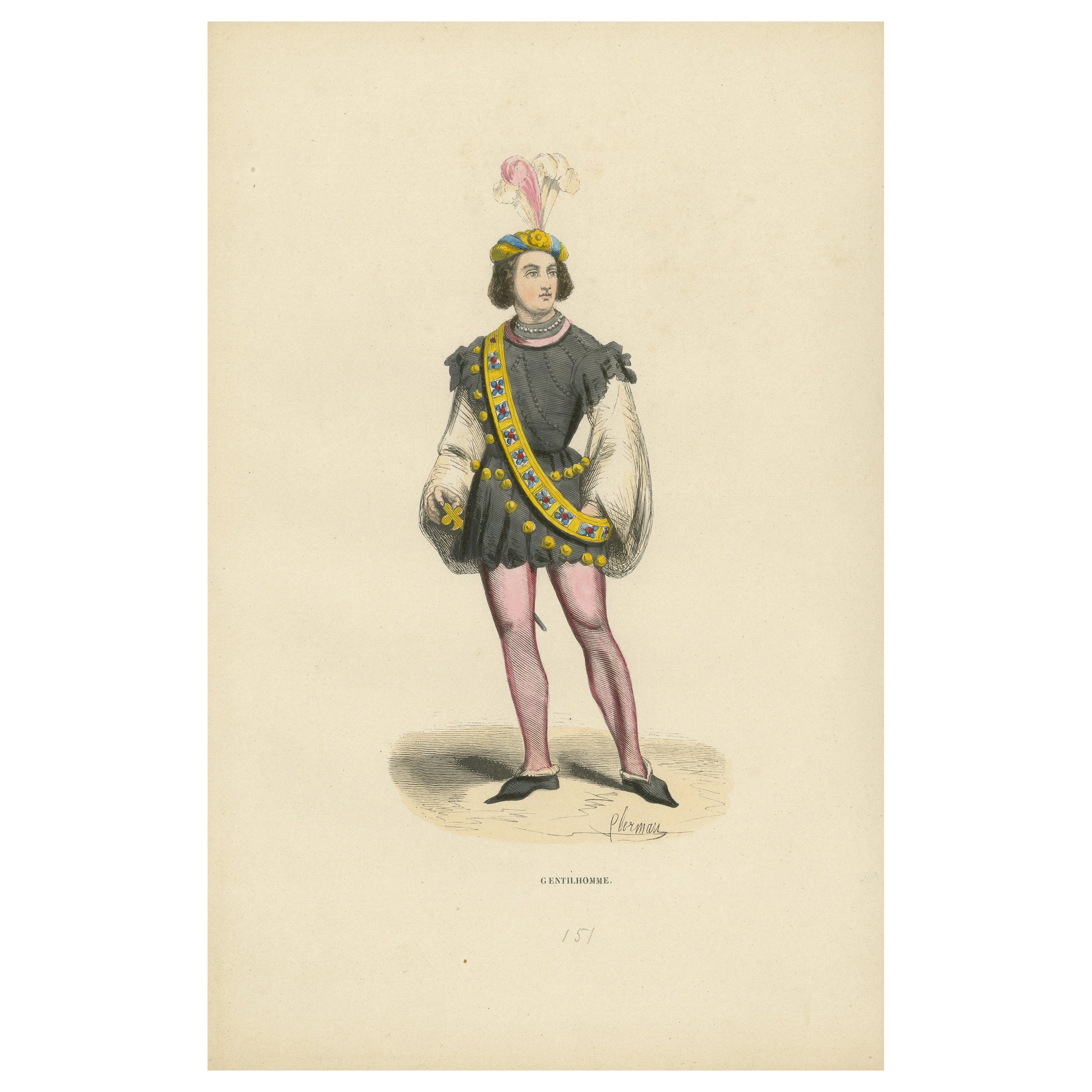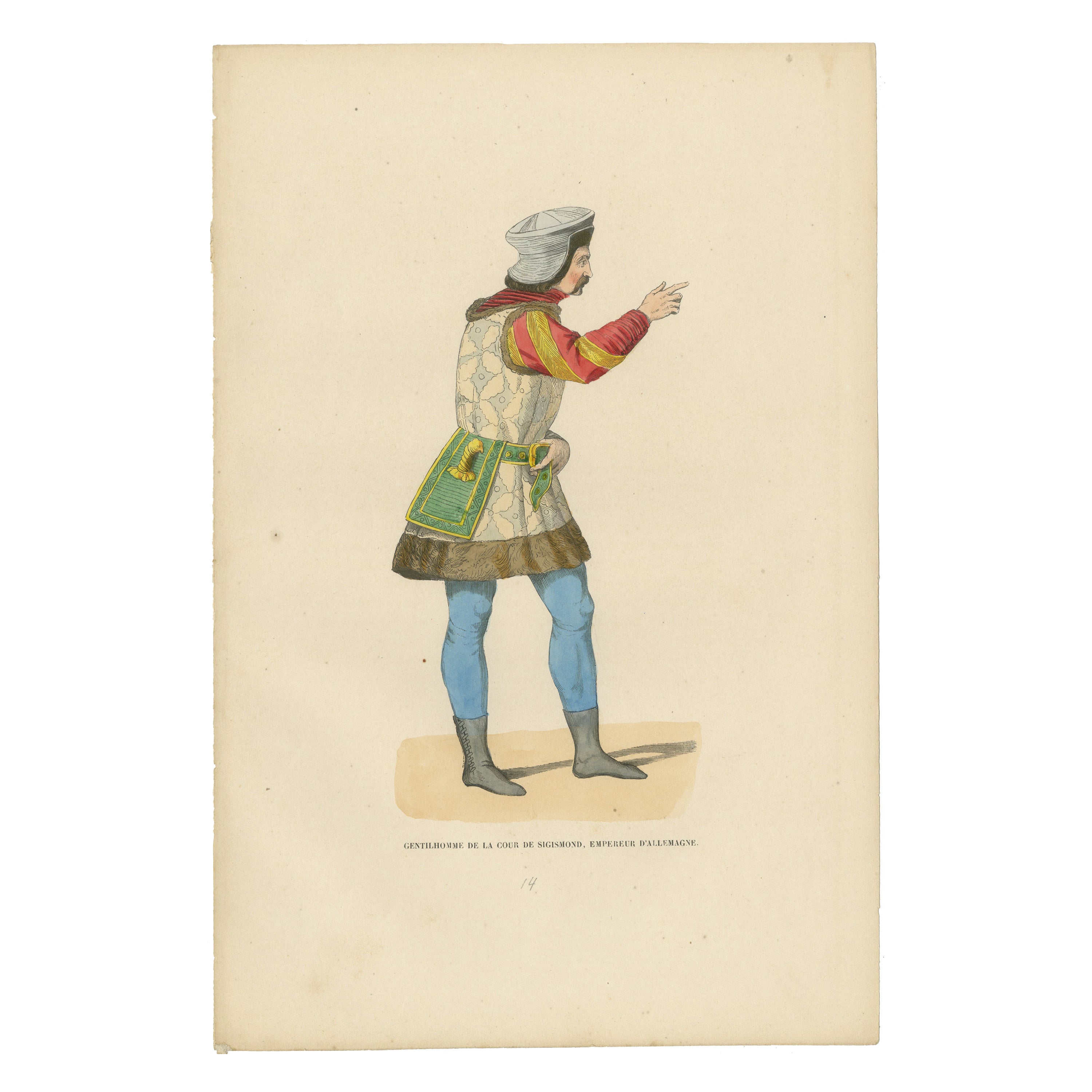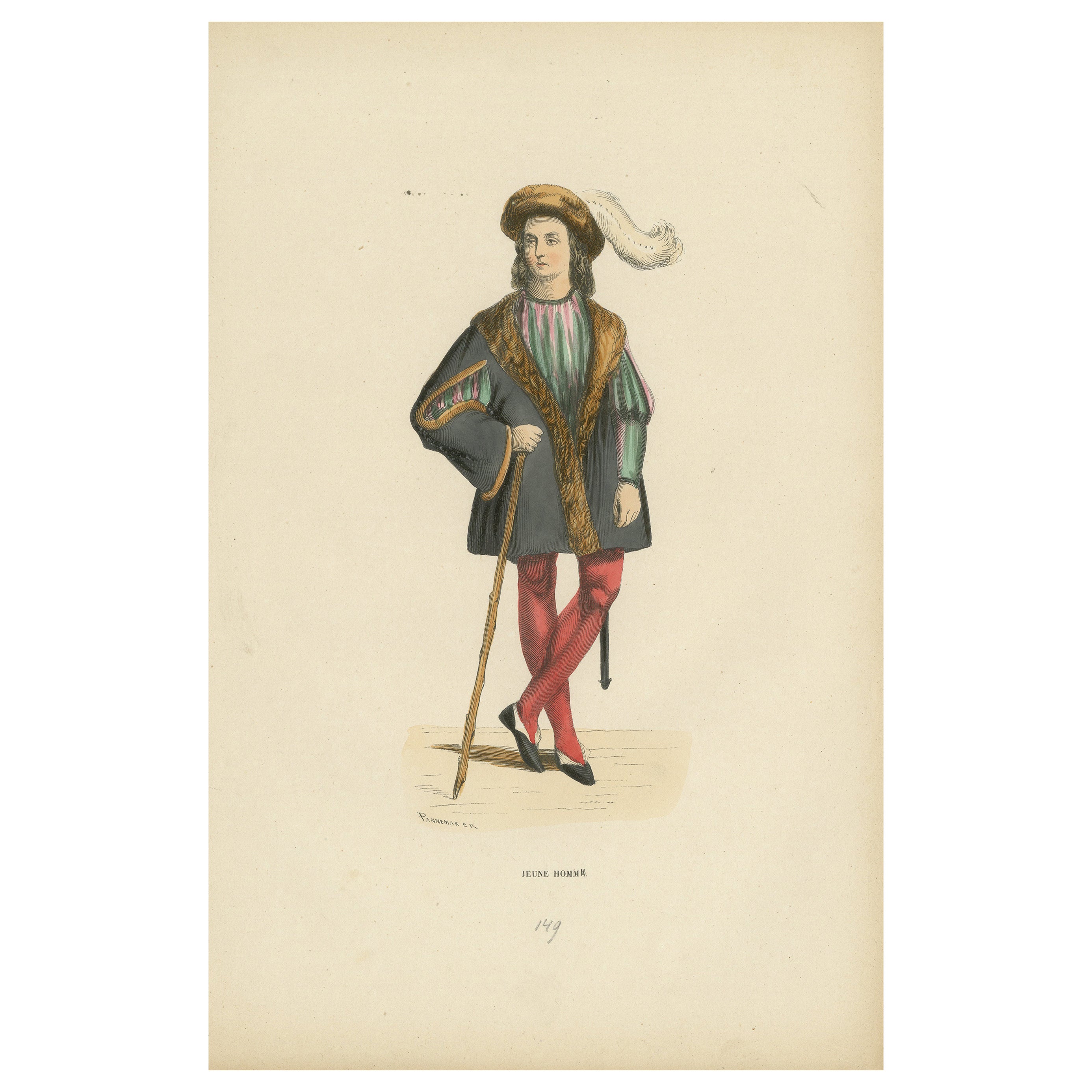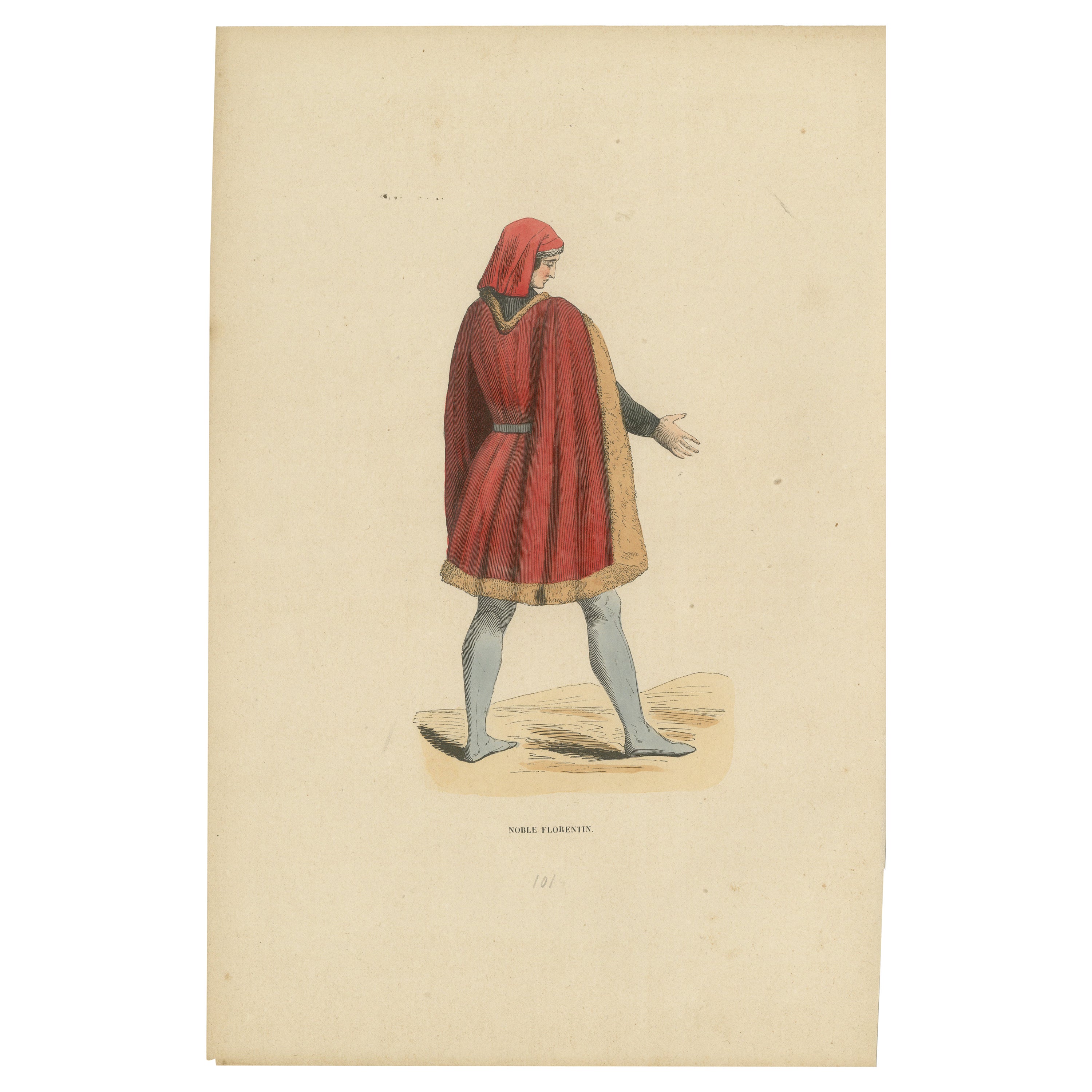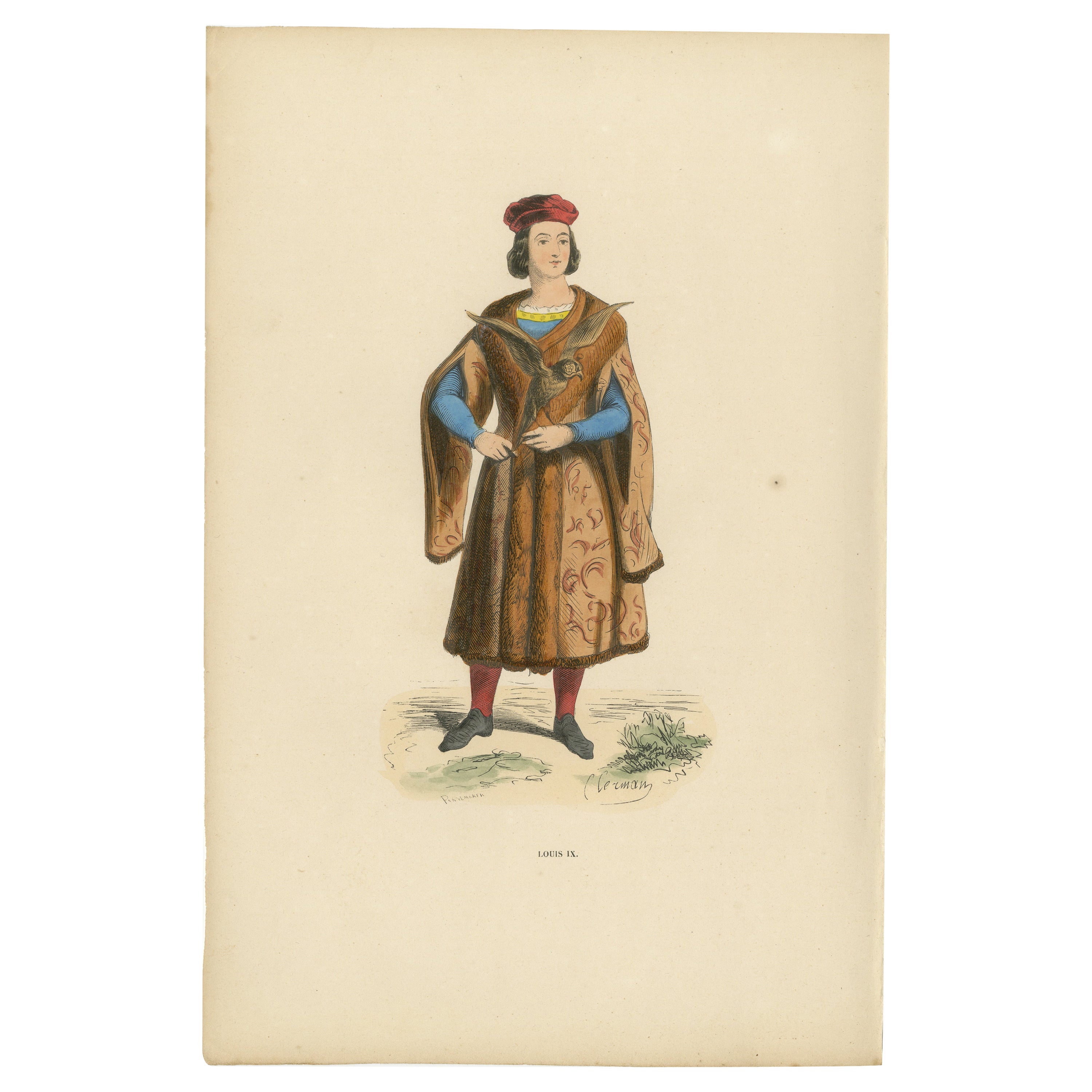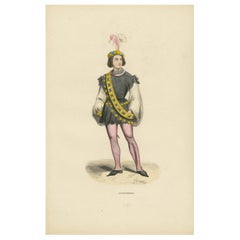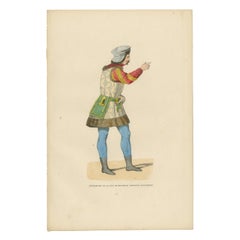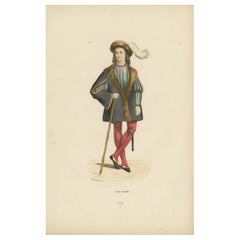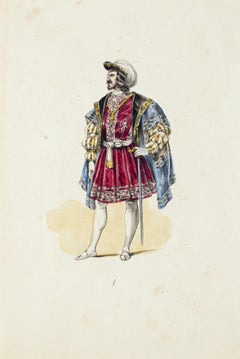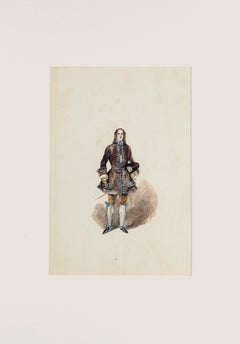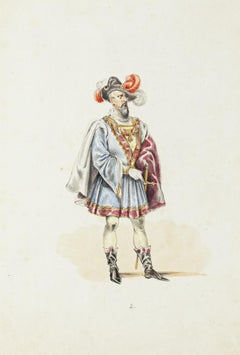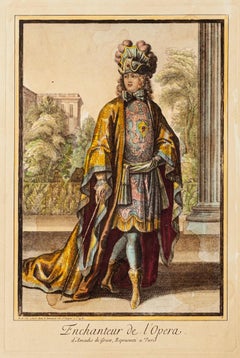Items Similar to Lord Beaumont in Courtly Attire, Costume Di Moyen Age, 1847
Want more images or videos?
Request additional images or videos from the seller
1 of 6
Lord Beaumont in Courtly Attire, Costume Di Moyen Age, 1847
$124.61
$155.7620% Off
£92.74
£115.9320% Off
€104
€13020% Off
CA$170.68
CA$213.3520% Off
A$189.83
A$237.2920% Off
CHF 99.13
CHF 123.9120% Off
MX$2,310.08
MX$2,887.5920% Off
NOK 1,265.98
NOK 1,582.4820% Off
SEK 1,187.27
SEK 1,484.0820% Off
DKK 791.72
DKK 989.6420% Off
Shipping
Retrieving quote...The 1stDibs Promise:
Authenticity Guarantee,
Money-Back Guarantee,
24-Hour Cancellation
About the Item
The image shows a figure labeled as "Lord Beaumont," depicted in medieval attire. He is wearing a blue overcoat with a fur trim and a gold-patterned undergarment that extends to his knees. His head is adorned with a red cap, a common headpiece for noblemen of the time. The style and cut of the clothing, along with the fur and fabric patterns, suggest wealth and status. Lord Beaumont is portrayed with a gesture that seems to indicate speaking or presenting, which might suggest his role in court or in council.
The source for this print is Costume Di Moyen Age, published 1847.
More about the vivid colors of this original hand-colored antique print:
The colors have a nice glow over them. Historically, egg whites, known as glair, and sometimes egg yolk were indeed used in illumination and painting, particularly in manuscripts, to give colors a brighter appearance and to add a sheen or gloss to the work. This technique was quite common during the Middle Ages and into the Renaissance.
Egg whites can be applied as a varnish over pigments to enhance their brightness and to protect the colors. This application could make the colors appear more vivid and also add a slight glossy sheen to the surface of the image.
Egg yolk, on the other hand, was commonly used as a binding agent in paint. It forms the basis of tempera paint, a medium that was widely used before the advent of oil painting. Egg yolk helps to create a durable and long-lasting color that adheres well to various surfaces.
In the context of the print from 1847, it's less likely that egg whites or yolks were used directly on the print, as by that time, commercial printing processes would have been more advanced and less reliant on such manual methods. However, if this print is a representation of an earlier style or is meant to mimic the appearance of hand-painted manuscripts, the original artists might have employed techniques or materials that gave a similar effect to those achieved with egg-based binders and varnishes.
- Dimensions:Height: 10.63 in (27 cm)Width: 7.09 in (18 cm)Depth: 0 in (0.02 mm)
- Materials and Techniques:
- Period:
- Date of Manufacture:1847
- Condition:Good. Overal very light toning and light soiling but the image itself clean and hand-colored almost 200 years ago and still in expliciet colors. Aged paper with typically warm, yellowish-brown hue, mostly around the edges.
- Seller Location:Langweer, NL
- Reference Number:Seller: BG-13635-361stDibs: LU3054337888922
About the Seller
5.0
Recognized Seller
These prestigious sellers are industry leaders and represent the highest echelon for item quality and design.
Platinum Seller
Premium sellers with a 4.7+ rating and 24-hour response times
Established in 2009
1stDibs seller since 2017
2,502 sales on 1stDibs
Typical response time: <1 hour
- ShippingRetrieving quote...Shipping from: Langweer, Netherlands
- Return Policy
Authenticity Guarantee
In the unlikely event there’s an issue with an item’s authenticity, contact us within 1 year for a full refund. DetailsMoney-Back Guarantee
If your item is not as described, is damaged in transit, or does not arrive, contact us within 7 days for a full refund. Details24-Hour Cancellation
You have a 24-hour grace period in which to reconsider your purchase, with no questions asked.Vetted Professional Sellers
Our world-class sellers must adhere to strict standards for service and quality, maintaining the integrity of our listings.Price-Match Guarantee
If you find that a seller listed the same item for a lower price elsewhere, we’ll match it.Trusted Global Delivery
Our best-in-class carrier network provides specialized shipping options worldwide, including custom delivery.More From This Seller
View AllThe Gallant Courtier: A Nobleman's Fashion in 'Costume du Moyen Âge, 1847
Located in Langweer, NL
Title: "The Gallant Courtier: A Nobleman's Fashion in 'Costume du Moyen Âge'"
Description: This 1847 lithograph from the "Costume du Moyen Âge" collection depicts a nobleman dressed...
Category
Antique 1840s Prints
Materials
Paper
$134 Sale Price
20% Off
Courtly Splendor: A Nobleman at Emperor Sigismund's Court, 1847
Located in Langweer, NL
The image depicts a man identified as a "Gentilhomme de la cour de Sigismond, empereur d'Allemagne," which translates to "Gentleman of the court of Sigismund, Emperor of Germany."
This individual is portrayed in a profile stance, dressed in attire that is indicative of the high-status courtiers during the time of Emperor Sigismund, who reigned in the early 15th century. He is wearing a turban-like headgear, which reflects the influence of Eastern fashion on European court attire, possibly due to the Ottoman influence or the general exchange of culture during the Crusades and subsequent interactions.
His doublet is richly patterned and he has puffed sleeves in red, which were fashionable among the nobility during the period. The garment is accented with a decorative belt that holds what appears to be a purse or a pouch. He also sports tight blue hose and pointed shoes, which complete the ensemble typical of a nobleman or a high-ranking court official in the Holy Roman Empire.
Egg whites can be applied as a varnish over pigments to enhance their brightness and to protect the colors. This application could make the colors appear more vivid and also add a slight glossy sheen to the surface of the image.
Egg yolk, on the other hand, was commonly used as a binding agent in paint. It forms the basis of tempera paint, a medium that was widely used before the advent of oil painting. Egg yolk helps to create a durable and long-lasting color that adheres well to various surfaces.
In the context of the print from 1847, it's less likely that egg whites or yolks were used directly on the print, as by that time, commercial printing processes would have been more advanced and less reliant on such manual methods. However, if this print is a representation of an earlier style or is meant to mimic the appearance of hand-painted manuscripts...
Category
Antique 1840s Prints
Materials
Paper
$153 Sale Price
20% Off
Youthful Elegance: A Young Gentleman's Attire in 'Costume du Moyen Âge', 1847
Located in Langweer, NL
Title: "Youthful Elegance: A Young Gentleman's Attire in 'Costume du Moyen Âge'"
Description: This lithograph, part of the 1847 "Costume du Moyen Âge" series, depicts a young gentle...
Category
Antique 1840s Prints
Materials
Paper
$162 Sale Price
20% Off
Noble Bearing: A German Gentleman in Medieval Attire, 1847
Located in Langweer, NL
Title: "Noble Bearing: A German Gentleman in Medieval Attire from 'Costume du Moyen Âge'"
Description: This 1847 lithograph from the esteemed collection "Costume du Moyen Âge" showc...
Category
Antique 1840s Prints
Materials
Paper
$172 Sale Price
20% Off
Florentine Nobleman of the Middle Ages, 1847
Located in Langweer, NL
Title: "Civilian Costume at the End of the 15th Century"
Description: The image is a print from a series the "Costume du Moyen Age" dated 1847, and titled "Costume Civil de la Fin du XVe Siècle," which translates to "Civilian Costume at the End of the 15th Century." It showcases a man of status, possibly a noble or a wealthy burgher, standing in a poised and confident manner.
He is attired in an ornate cloak covered in a complex pattern of fleur-de-lis and cross motifs, indicative of wealth and possibly a connection to royalty or high social rank. The cloak is open at the front to reveal a blue doublet with a belt, and he wears red hose—a fashion staple of the late medieval period. His footwear is also red, which stands out against the more subdued tones of his outfit.
On his head, he sports a fur-trimmed hat, adding to the luxuriousness of his attire. In one hand, he holds a long staff, which serves as both a walking aid and a symbol of authority. His other hand rests on the hilt of a dagger, further indicating his readiness to defend his status or engage in the political or civic matters of his time.
The artist has skillfully rendered the textiles and accessories with great care, emphasizing the fashion and social cues of the late 15th-century European society.
The colors have a nice glow over them. Historically, egg whites, known as glair, and sometimes egg yolk were indeed used in illumination and painting, particularly in manuscripts, to give colors a brighter appearance and to add a sheen or gloss to the work. This technique was quite common during the Middle Ages...
Category
Antique 1840s Prints
Materials
Paper
$124 Sale Price
20% Off
Louis IX: A Portrayal of French Royalty in Medieval Attire, Published in 1847
Located in Langweer, NL
The image is a hand-colored engraving titled "Louis IX," representing the 13th-century King of France, also known as Saint Louis, renowned for his Christian zeal and justice. It is p...
Category
Antique 1840s Prints
Materials
Paper
$162 Sale Price
20% Off
You May Also Like
Theatrical Costume - Original Lithograph - Early 20th Century
Located in Roma, IT
Theatrical Costume is a splendid hand lithograph engraved by Anonymous Artist in the Early 20th Century.
The state of preservation of the artwork is e...
Category
Early 20th Century Modern Figurative Prints
Materials
Lithograph
Costume - Original Hand-colored Lithograph - 19th Century
Located in Roma, IT
Costume is original Hand-colored lithograph realized by an Anonymous artist in the late XIX century.
Included a Passepartout: 52.5 x 37cm.
Very good conditions.
The artwork represents the traditional costume, skillfully depicted through soft and precise strokes, the artwork is created with congruous harmonious colors from historical costume...
Category
19th Century Modern Figurative Prints
Materials
Lithograph
Theatrical Costume - Original Lithograph - Early 20th Century
Located in Roma, IT
Theatrical Costume is a splendid hand lithograph engraved by Anonymous Artist in the Early XX Century.
The state of preservation of the artwork is exc...
Category
Early 20th Century Modern Figurative Prints
Materials
Lithograph
Theatrical Costume - Lithograph on Paper - Late 19th Century
Located in Roma, IT
Theatrical Costume is original lithography realized by an Anonymous artist in the late 19th Century.
Good conditions with two stain on the lower and some decoloration on the margins of its Passpartout.
The artwork represents a standing man wearing the theatrical costume, skillfully depicted through soft and precise strokes, the artwork is created with congruous harmonious colors from historical costume...
Category
Late 19th Century Modern Figurative Prints
Materials
Lithograph
Original Antique Print of A French Aristocratic Gentleman After Lebrun. C.1900
Located in St Annes, Lancashire
Beautiful image by Elisabeth Lebrun
Photogravure
Published by Connoisseur. C.1900
The measurement is the paper size
Unframed
Category
Antique Early 1900s English Louis XV Prints
Materials
Paper
Ancient Costume - Original Lithograph - Mid 19th Century
Located in Roma, IT
Ancient Costume is an original lithograph hand-colored, realized by an anonymous artist of the XIX century
The state of preservation of the artwork is...
Category
Mid-19th Century Figurative Prints
Materials
Lithograph
More Ways To Browse
Antique Burled Walnut Chest Of Drawers
Antique French Filing Cabinet
Antique Frock Coat
Antique Germany Creamer
Antique Glass Canisters
Antique Glass Powder Boxes
Antique Horse Wagon
Antique Hunting Accessories
Antique Hunting Pack
Antique Metal Rooster
Antique Metal Tea Pot
Antique Necessaire
Antique Pie Case
Antique Pill Box Gold
Antique Sake Set
Antique Silver Boxes Repousse
Antique Storm Glass
Antique Thimbles
